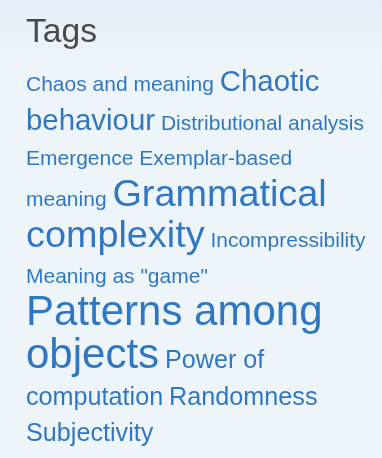Theoretical Outline
Linguistics attempts to find a system for language.
In common with broader science this search has moved in the direction of seeking general laws, or rules, broadly speaking grammar.
The conjecture of this website is that such rules cannot be abstracted for natural language.
Looked at more broadly this seems to be part of a general revision of the place of theory in science. Godel’s mathematical incompleteness appears to be a version of it. Stephen Wolfram’s “computational irreducibility” appears to be a version of it.
At root though, the idea does not require sophisticated mathematics or physics to grasp. It can be as simple as the intuition there might be more ways of arranging a set of objects meaningfully, than there are objects themselves.
The claim sounds innocuous enough, and unlikely to hold much interest outside of mathematics. But it has significant practical consequences.
In particular from the point of view of natural language it implies that there may be more regularities, and thus apparent rules, among the sentences of a natural language, than there are sentences in the language. Hence that natural language may be in a very precise way “irregular”. More exactly that it will need to be modeled as an automaton and not a set of rules.
An exploration from the point of view of language has revealed similar ideas in a diverse range of disciplines, including mathematics, and cognition.
The unifying thread might be summarized as “complex” or chaotic behaviour. It is at least conjectured that these ideas are related to the very young study of “complex” or chaotic systems.
We are only beginning to understand the implications of such systems. In fact they seem to go very deep and redefine even our usual conception of science itself as the regular expression of principles.
The aim of this site is to collect together a range of such ideas from a number of fields in the hope that researchers might be encouraged to compare notes, and that linguists in particular might be led to rethink some traditional problems which have fractured the subject into distinct “schools” (either rejecting structure or rejecting distributional analysis) and broadly prevented progress.
The intention is that users should access the site by clicking on “tags”, listed left, which reflect their interest, and then follow tags within the articles linked to, revealing hidden connections. It is the tags which pull the site together, as befits a site of which the basic premise is that there is fundamentally more than one way of organizing any (sufficiently complex) set of information.

